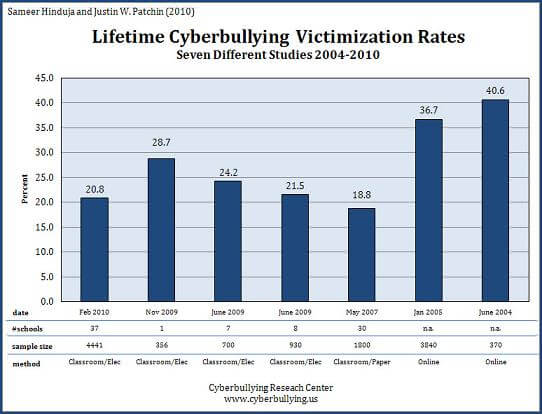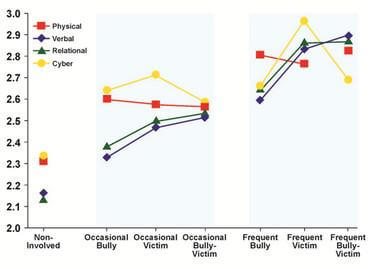
The internet can provide us with many things, but it can’t help us avoid adolescence. The rise of social media in the past decade has also seen the advent of cyber bullying, the willful and repeated attacks on minors using electronic means. From taunts and rumors, to threats and stalking, cyber bullying takes many forms but isn’t so different from traditional bullying that’s always been found in schools. Cyber bullying however, may be particularly dangerous for mental health. A traditional bully is often finished when a child reaches home but cyber attackers can ‘follow’ their victims online, tormenting them 24/7 and in front of a much larger crowd. This can cause children to feel there is no escape. And with anonymity so readily available on the internet, many students may feel emboldened to act cruelly to their peers in ways they wouldn’t dream of in a school. As our children prepare themselves for a life online, cyber bullying is an increasingly high hurdle that many have to pass on the path to adulthood. Recent cases of suicides have only highlighted how dangerous and difficult clearing that hurdle has become.
Many of the same things that make the new media better and more flexible than old media also increase the potential effects of bullying. A single foolish incident caught on video or camera phone can be spread via SMS or Twitter or Facebook to thousands in just minutes. Viral marketing is a cyberbully’s best friend. Additionally, web presences on social media (the classic examples being a Facebook Wall or MySpace page) give bullies targets they can hit any time day or night. Add a disparaging remark about a picture, post a photo-shopped copy of it that further humiliates the subject, and then spread that information to everyone you and the victim know. It’s quick and it’s easy. And it’s devastating. One of the most recent cases of suicide linked to cyber bullying simply required sharing a video shot surreptitiously from a webcam. Sure, it involved a sexual encounter, but otherwise it was a pretty classic bully technique: get embarrassing information and share it with the world.
Both the situation itself and our awareness of it have been heightened. Is that attention alone going to help end cyber bullying? Probably not. Despite all the media coverage, it can still be difficult to relate to adults the seriousness of these incidents, and the hopelessness felt by many victims. For many of us who did not grow up surrounded by the internet and social media, it may be hard to relate how important, seemingly vital, a web presence is for a young person. You can’t simply unplug and walk away. The internet is where you talk to your friends, laugh at jokes, even get your homework. It’s seen as essential. Which is why cyberbullying is so dangerous. Imagine a traditional bully who could not only embarrass you, but affect your ability to speak and hear and see. When someone is leaving insults on your Facebook page, tweeting about how big a loser you are, and emailing insulting pictures of you, the internet can seem like a minefield. A minefield you are forced to walk through everyday. That may be difficult to fully understand if you don’t live it, but experts are trying to get the message across to parents and students. Justin Patchin of the Cyberbullying Research Center gives a good primer about cyberbullying in the video below:
Different organizations have varying statistics on the prevalence of cyber bullying. The NIH’s 13.6% figure comes from a World Health Organization study called the Health Behavior in School Age Children (HBSC). The US Health Resources and Services Administration’s Stop Bullying Now website quotes several studies placing incidence between 1 in 5 and 1 in 3 students. The Cyberbullying Research Center says lifetime victimization rates have been as high as 40% with offenders making up to 20% of student populations. That second figure is very disturbing, and speaks to how easily we can be seduced into cyberbullying others. Parents must not only help defend their children against attacks, but help children realize that enabling those attacks is dangerous and wrong. So much of online culture involves brutal honesty, schadenfreude, and sharing opinions. We need to realize that the line between good natured humor and bullying is much thinner than we realize. For now, no matter which numbers we choose to go by, digital bullying seems to be a problem on the rise.

With the new kind of bullying comes a new psychology of its offenders and victims. The news here is bad. Usually, the factors that cause a student to bully another will also make the bully more likely to suffer from depression than their victim. A recent NIH study found, however, that victims of cyber bullying are more likely to suffer from depression than their attackers. Anonymity on the web makes attacking someone relatively easy and pain free, but doesn’t dampen the sting on the receiving end. The NIH’s data suggests that those who suffer from cyber bullying are more troubled by feelings of depression than those who experience more traditional face to face bullying. They also highlight how those who are cyber victims suffer more than those who are only cyber bullies or those who are both cyber bullies and victims (referred to as bully-victims). Clearly cyber bullying is offering a new kind of mental health issue for our children.

If there is a silver lining to the cloud of bullying, it’s that the same tools that make cyber attacks easy and prevalent can also be used to educate and inform those who wish to oppose it. A simple Google search will yield dozens of sites dedicated to ending cyberbullying locally and globally. All the organizations mentioned above have anti-bullying programs on the internet. Most agree that the best defense against a bully is parent and family support. According to the NIH, studies found that students who felt they had the support of their parents and families were less likely to become bullies or to be victimized. While peer-relations may be the basis for bullying, filial relations seem to be the cure.
As always, we are presented with new challenges as our society adapts to new technologies. The important thing to remember, I think, is that while some risks may be amplified, solutions are often created to match them. True, online activity makes it easier than ever for students to anonymously spread damaging rumors about others. Yet our social networks have given us the tools to block offenders, filter messages, and record those attacks against us. Facebook is already enabling students to report hazardous messages, and offenders can be booted off the system. That still leaves text messages, emails, and many other venues, but each has their own method of recourse. Tracking offenders, even anonymous ones, is easier than they would believe. The fact is, if we can get students to report their bullying to parents, we can stop most instances of abuse. Establishing that communication, of course, has been one of the great challenges of parenthood since time immemorial. Perhaps if we are honest about the real dangers associated with bullying, our children will be more likely to come forward and seek our help if they or their friends are confronted by it. We can hope.
[image credits: Chris Kasurak]
[source: Cyberbullying Research Center, NIH, Wang et al J. Adolesc. Health 2009]


